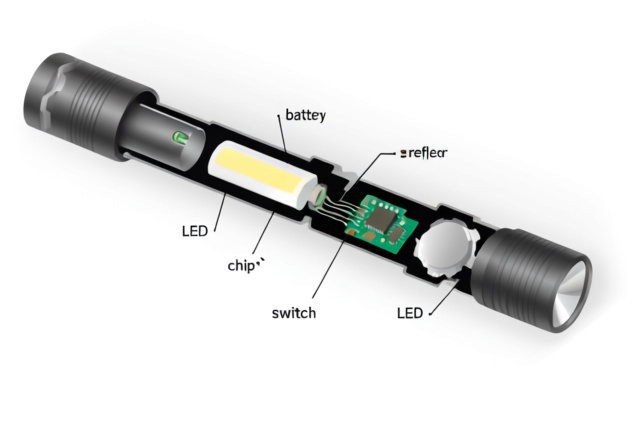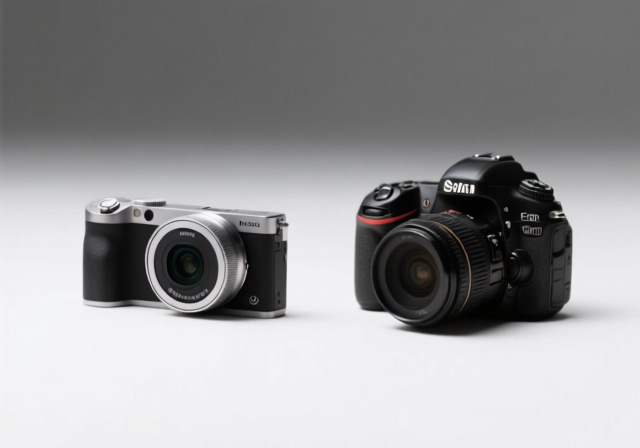

Ever found yourself fumbling in the dark, desperately searching for something? That’s when the humble flashlight becomes your best friend. This simple yet brilliant invention has been illuminating our lives since 1899, transforming darkness into light with just the click of a button.
How does a flashlight work? When you turn on a flashlight, you complete an electrical circuit that allows electricity to flow from batteries through a switch to a light source (LED or bulb), which then emits light that’s focused into a beam by a reflector.
After testing countless flashlights and studying their inner workings, I’ve discovered that this everyday device is actually a fascinating example of electrical engineering at its most practical. From camping trips to emergency power outages, flashlights provide reliable light when and where we need it most.
In this comprehensive guide, I’ll walk you through every component and process that makes modern flashlights work, from the basic circuit principles to the cutting-edge LED technology that’s revolutionized portable lighting.
Every flashlight, whether it’s a simple $2 plastic model or a $200 tactical beast, relies on the same fundamental components working together. Understanding these parts is key to grasping how flashlights convert electrical energy into brilliant light.
Batteries are the heart of any conventional flashlight. These electrochemical cells store chemical energy and convert it into electrical energy when needed. Most flashlights use disposable alkaline batteries, though rechargeable lithium-ion options are becoming increasingly popular due to their superior performance and eco-friendliness.
Battery Terminal: The metal contact points at each end of a battery that allow electrical current to flow into and out of the battery.
The battery configuration varies by flashlight design. Some use AA or AAA cells arranged in series, while others use specialized 18650 lithium cells for higher power output. The voltage and capacity of these batteries directly affect brightness and runtime.
Think of the switch as the gatekeeper of your flashlight’s electrical circuit. When off, it creates a break in the electrical path, preventing current flow. When you flip or press the switch, it completes the circuit, allowing electricity to surge toward the light source.
Modern flashlights often feature sophisticated switches with multiple modes – low, medium, high, and sometimes strobe or SOS functions. These are controlled by electronic circuits that pulse the power rapidly, effectively dimming the light by turning it on and off faster than your eye can detect.
These unsung heroes are the highways for electrical current. Typically made of brass or copper, contact strips run along the length of the flashlight, connecting the batteries to the switch and light source. Good electrical contact is crucial – even minor corrosion or poor connections can prevent your flashlight from working.
This is where electricity transforms into visible light. Modern flashlights primarily use LEDs (Light Emitting Diodes), while older models used incandescent bulbs with tiny tungsten filaments. The light source efficiency dramatically affects battery life and brightness.
A parabolic reflector sits behind the light source, collecting and focusing the emitted light into a usable beam. The texture and shape of this reflector determine whether you get a tight spotlight or a wide flood beam. Some flashlights feature adjustable focus, allowing you to switch between beam types.
The clear lens at the front of the flashlight serves multiple purposes. It protects the delicate reflector and light source from damage and dust, while also helping to shape and smooth the beam pattern. High-end flashlights use coated lenses that maximize light transmission.
The outer casing holds everything together and provides protection. Materials range from plastic for budget models to aircraft-grade aluminum for premium tactical lights. The housing also provides grip and often includes features like water resistance and impact protection.
Understanding how electricity flows through a flashlight is like following a map from the power source to the light output. This elegant circuit demonstrates fundamental electrical principles that power many of our everyday devices.
This entire process happens almost instantaneously – faster than you can blink. The speed of electrical current is approximately 60% of the speed of light, meaning the journey from battery to bulb takes mere nanoseconds.
Every component in the circuit contributes to electrical resistance. The light source is designed to have specific resistance that limits current flow to the optimal level. Too much current would burn out the light source, while too little would produce dim light.
This is why using the correct battery type matters. A 3.7V lithium battery in a flashlight designed for 1.5V alkaline cells might provide brighter light initially but could quickly damage the LED or circuitry.
Today’s LED flashlights often include sophisticated circuit boards that regulate power delivery. These circuits maintain consistent brightness as batteries drain and can convert excess voltage into usable current, making the most of available power.
Some advanced flashlights feature voltage boost circuits that can extract useful energy from batteries that would otherwise be considered dead in simpler devices. This is why your modern LED flashlight might continue working long after other devices with the same batteries have stopped.
The way your flashlight produces light depends entirely on its light source technology. Let me break down the two main types and why LEDs have completely transformed portable lighting.
| Feature | LED Technology | Incandescent Technology |
|---|---|---|
| Efficiency | 70-120 lumens/watt | 10-17 lumens/watt |
| Lifespan | 25,000-100,000 hours | 1,000-2,000 hours |
| Heat Output | Low (warm to touch) | High (can burn skin) |
| Durability | Virtually shockproof | Fragile filament |
| Color Temperature | 2700K-6500K (adjustable) | 2700K-3000K (warm yellow) |
Light Emitting Diodes work through a fascinating process called electroluminescence. When electrical current passes through the semiconductor material, electrons jump from a higher energy state to a lower one, releasing energy in the form of photons (light particles).
What makes LEDs so efficient is that nearly all the electrical energy converts directly to light, with minimal wasted heat. The color of the light depends on the semiconductor materials used – different compounds produce different wavelengths of light.
Quick Summary: LEDs are semiconductor devices that convert electricity directly into light with up to 90% efficiency, compared to incandescent bulbs which waste most energy as heat.
Traditional incandescent bulbs work on a much simpler principle: resistance heating. Electricity passes through a thin tungsten filament, heating it to around 4,500°F (2,500°C) – hot enough to glow brightly and produce visible light.
The problem? Up to 90% of the electrical energy converts to heat rather than light. This inefficiency explains why incandescent flashlights eat batteries and can get uncomfortably hot during use. The filament is also fragile – a single drop can break it.
The shift to LED technology has been nothing short of revolutionary. Modern LED flashlights can produce 10-20 times more light per battery than their incandescent predecessors. They’re also more durable, with no fragile parts to break.
Perhaps most impressively, LED efficiency continues to improve. The latest Cree and Luminus LEDs used in high-end flashlights can produce over 200 lumens per watt – bright enough to illuminate objects hundreds of feet away while sipping power from tiny batteries.
Flashlights come in an astonishing variety of shapes, sizes, and power systems. Understanding these variations helps you choose the right tool for your needs and appreciate the engineering behind different designs.
These compact powerhouses typically measure 3-6 inches and run on 1-2 AA or CR123A batteries. EDC lights focus on balance – enough brightness for most situations (100-500 lumens) while remaining pocket-friendly. Many feature pocket clips and multiple brightness modes.
EDC Flashlight: A compact, durable flashlight designed for everyday carry, typically featuring high efficiency and multiple brightness modes optimized for daily use scenarios.
Built for military, police, and security use, these lights emphasize rugged construction and high output. Features include weapon-mounting capabilities, strike bezels for self-defense, momentary-on switches, and blinding brightness (500-2000+ lumens). They often use rechargeable lithium-ion batteries for maximum performance.
Perfect for hiking, camping, or working in tight spaces, headlamps keep your hands free while directing light exactly where you look. Modern LED headlamps can run for hundreds of hours on low settings and often feature red-light modes to preserve night vision.
Beyond conventional batteries, several innovative power systems have emerged:
The flashlight world includes specialized designs for specific tasks:
Flashlights serve countless purposes beyond just lighting up dark spaces. Their versatility makes them essential tools in numerous situations and professions.
During power outages, flashlights become lifelines. Every home should have multiple flashlights strategically placed – bedside, in the kitchen, near exits. Modern LED models can run for days on a single set of batteries, providing reliable illumination when you need it most.
I’ve seen firsthand how crucial good flashlights are during natural disasters. After Hurricane Sandy, families with quality LED lights fared much better than those relying on candles or cheap plastic flashlights that quickly failed.
Campers, hikers, and hunters depend on flashlights for navigation, safety, and campsite tasks. The evolution from bulky D-cell lights to compact lithium-powered marvels has transformed outdoor experiences. Modern headlamps allow hikers to continue after dark, while powerful spotlights help hunters track game.
For low-light photography techniques, flashlights can be used for light painting and illuminating foreground elements in night scenes.
Electricians, mechanics, and inspectors use specialized work lights with magnetic bases and flexible necks. Search and rescue teams rely on high-output spotlights that can cut through fog and rain. Police and security personnel use tactical lights for both illumination and non-lethal defense.
Sometimes the simplest uses matter most. Finding lost items under furniture, walking the dog at night, checking circuit breakers, or navigating during late-night bathroom trips – these everyday moments showcase why flashlights remain indispensable tools.
A flashlight works by completing an electrical circuit when you turn it on. Electricity flows from batteries through a switch to a light source (LED or bulb), which converts electrical energy into light. A reflector then focuses this light into a beam, and a lens helps shape and protect the output.
Modern flashlights use LEDs that generate light through electroluminescence – when electricity passes through semiconductor materials, electrons release energy as photons (light particles). Older incandescent flashlights work by heating a tungsten filament until it glows, similar to a regular light bulb.
Battery-free flashlights use alternative power sources like hand-crank dynamos (generating electricity through mechanical motion), solar panels (converting sunlight to electricity), supercapacitors (storing electrical charge), or thermoelectric generators (converting heat differences into electricity). These are often used for emergency preparedness.
No, flashlights cannot work without an energy source due to the law of conservation of energy. Light requires energy, and flashlights must get this energy from somewhere – whether batteries, kinetic energy from shaking/cranking, solar power, or another electrical source. Perpetual motion machines that create energy from nothing violate fundamental physics principles.
EDC stands for Everyday Carry – compact flashlights designed for daily use. These lights typically measure 3-6 inches, run on common batteries (AA, AAA, or CR123A), and offer 100-500 lumens. They’re built for portability and reliability, often featuring pocket clips, multiple brightness modes, and durable construction suitable for daily tasks and emergencies.
LED flashlights can last 25,000 to 100,000 hours of use, compared to 1,000-2,000 hours for incandescent bulbs. At typical usage patterns, an LED flashlight could last decades before the LED fails. Battery life varies widely depending on brightness settings, ranging from 1-2 hours on maximum brightness to hundreds of hours on low settings.
Flashlight technology continues to evolve at a rapid pace. We’re seeing OLED technology that could create flexible, panel-style lights, improved battery chemistries offering higher energy density, and smart flashlights with Bluetooth connectivity and programmable modes.
What won’t change is the basic principle that makes flashlights work – the elegant simplicity of converting electrical energy into portable, directed light. From the crude incandescent lights of the early 1900s to today’s high-tech LED marvels, flashlights remain one of the most practical and reliable tools ever invented.
Whether you’re preparing for emergencies, exploring the great outdoors, or just need to find your keys in the dark, understanding how your flashlight works helps you appreciate this remarkable device that turns darkness into light with the simple flip of a switch.



